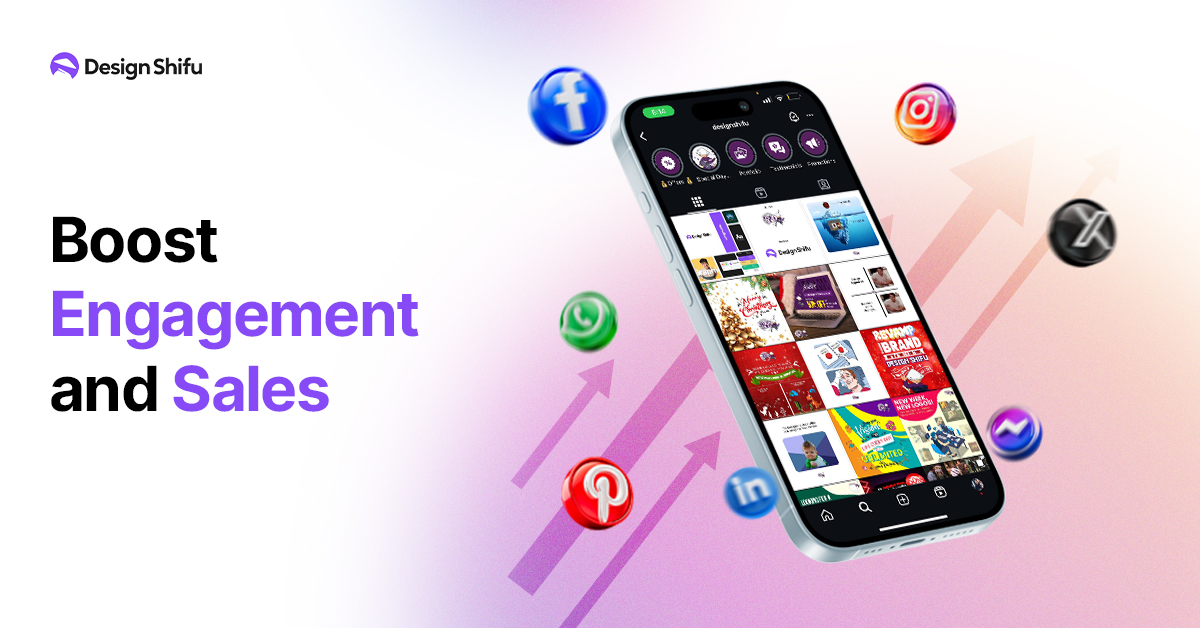Buckle up, small and medium business owners! In our first impression world, your logo is your business cape—a dramatic, memorable, attention-grabbing piece of art!
Whether you are a quaint little café, a new tech startup, or anything in between, logo design for small and medium businesses will help you carve out your niche in a crowded marketplace.
This guide will cover why a great logo is important, the logo design process, and practical tips so you will end up with a logo that shouts you! Are you ready to take your brand from unbranded to branded? Let’s start our journey together and create a logo that will turn heads!
Don’t let your brand be normal and boring—let’s get to work and get you an iconic logo!
TL;DR
- An effective logo is essential for small and medium businesses to develop brand awareness and communicate values, while also being distinct and memorable to the prospective customer.
- Aim for simplicity, relevance, versatility, and timelessness. Follow a design process, avoid common mistakes, and use resources (or people) to help you think through the process and create an effective logo.
- In a crowded marketplace, whether online or in store, differentiate, and be remembered!
- Measure the success of a logo by soliciting feedback from the customer, and looking at engagement with the logo.
Why Logo Design Matters for Small and Medium Businesses
For small and medium businesses (SMBs), a logo is more than a pretty picture—it’s a visual handshake with your audience.
Logo design for small and medium businesses plays a pivotal role in establishing credibility and trust, especially when competing with larger brands.
Here’s why it’s a game-changer
- Instant Recognition: A memorable logo helps customers spot your brand in a sea of competitors, like a lighthouse guiding them to your business.
- Brand Identity: Your logo communicates who you are—whether you’re a quirky boutique or a reliable service provider.
- Cost-Effective Marketing: A versatile logo works across business cards, websites, and social media, maximizing your marketing ROI.
For SMBs with limited budgets, logo design for small and medium businesses is a high-impact, low-cost way to make a lasting impression.
Ready to make your brand unforgettable? Don’t wait—tie your logo into a powerful brand identity and launch a look that truly pops.
Core Elements of a Great Logo for SMBs
Creating a logo that resonates requires balancing creativity and strategy. Here are the key elements to focus on for logo design for small and medium businesses:
1. Simplicity
A clean, uncluttered logo is easy to recognize and reproduce. Think of logos like McDonald’s golden arches or Airbnb’s simple symbol—they’re iconic yet straightforward. Simplicity is key in logo design for small and medium businesses to ensure it works on everything from storefronts to social media icons.
2. Relevance
Your logo should reflect your industry and audience. A fitness studio might use bold, energetic designs, while a law firm might opt for sleek, professional typography. Ensure your logo aligns with your SMB’s unique vibe.
3. Versatility
SMBs need logos that shine across platforms—business cards, websites, product packaging, and more. A versatile logo looks great in color, black and white, and at any size. This adaptability is critical for logo design for small and medium businesses.
4. Timelessness
Avoid trendy designs that may feel dated in a few years. Classic logos like those of Levi’s or Chanel endure because they prioritize longevity. Aim for a timeless design to future-proof your SMB’s brand.
5. Color Psychology
Colors shape perceptions—blue evokes trust, yellow sparks optimism. Choose colors that align with your brand’s personality and resonate with your target market, a vital aspect of logo design for small and medium businesses.
6. Typography
Fonts set the tone. Playful scripts suit creative businesses, while bold sans-serif fonts scream modernity. Ensure readability, especially for small sizes, to make your logo effective across contexts.
Want a logo that’s simple, relevant, and timeless? Get started with a professional designer or tool today!
The Logo Design Process for SMBs
Creating a logo doesn’t have to be daunting. Here’s a step-by-step guide to streamline logo design for small and medium businesses:
Step 1: Craft a Brand Brief
Outline your business’s mission, values, target audience, and competitors. Specify preferred colors, styles, or inspirations. This brief guides designers to create a logo that aligns with your vision.
Step 2: Research and Inspiration
Explore competitor logos and industry trends. Platforms like Dribbble or Pinterest can spark ideas, but keep your design unique. Research ensures your logo stands out in logo design for small and medium businesses.
Step 3: Work with a Designer or Tool
SMBs can hire a freelance designer, work with an agency, or use tools like Canva or Looka for budget-friendly options. Choose a designer experienced in logo design for small and medium businesses for best results.
Step 4: Review and Refine
Evaluate initial logo concepts based on simplicity, relevance, and versatility. Provide clear feedback to refine the design. Involve key team members to ensure buy-in.
Step 5: Test Across Platforms
Test your logo on business cards, websites, social media, and product packaging. Ensure it’s legible and impactful in all scenarios, a must for logo design for small and medium businesses.
Step 6: Launch and Integrate
Roll out your logo across all touchpoints—update your website, social media, and marketing materials. Create brand guidelines to ensure consistent usage, protecting your SMB’s identity.
Don’t wait—launch your brand’s new look with a logo that pops using Design Shifu’s unlimited graphic design services.
Common Mistakes to Avoid
Even savvy SMB owners can stumble during logo design for small and medium businesses. Watch out for these pitfalls:
- Overloading the Design: Too many colors or elements can confuse customers.
- Ignoring Scalability: A logo that looks great on a website may fail as a tiny favicon.
- Chasing Trends: Trendy logos age poorly, costing you a rebrand sooner than expected.
- Skipping Feedback: Not involving customers or team members can lead to a misaligned design.
- No Brand Guidelines: Inconsistent logo use weakens your brand’s impact.
Tools and Resources for SMB Logo Design
You don’t need to be a design pro to oversee logo design for small and medium businesses. Here are tools and resources to help:
- Canva: Easy-to-use for DIY logos or mockups, perfect for budget-conscious SMBs.
- Adobe Express: Offers templates and customization for quick logo creation.
- Figma: Ideal for collaborative design with your team or designer.
- Looka or Hatchful: AI-powered logo makers for fast, affordable designs.
- Freelance Platforms: Upwork or 99designs connect you with skilled designers.
For standout results, consider hiring a professional specializing in logo design for small and medium businesses. Explore these tools or hire a pro to craft your perfect logo today!
Logos in SMB Marketing Strategies
Your logo is a marketing powerhouse, tying together your SMB’s campaigns. Here’s how it shines in logo design for your businesses
- Social Media: A logo that’s clear in small profile pictures boosts brand visibility.
- Print Materials: From flyers to business cards, your logo ensures consistency.
- Website and SEO: A logo in your site’s header enhances user experience and brand recall.
- Product Packaging: A logo on products builds trust and recognition.
Integrate your logo strategically to amplify your SMB’s marketing efforts.
Measuring Logo Success
After launching your logo, track its impact with these metrics:
- Brand Recall: Ask customers if they recognize your logo and associate it with your business.
- Engagement: Monitor website and social media metrics to see if the logo drives interaction.
- Customer Feedback: Gather input via surveys or reviews to gauge perception.
- Consistency: Audit marketing materials to ensure the logo is used correctly.
These insights refine your approach to logo design for small and medium businesses.
Conclusion
For small and medium businesses, a logo is your brand’s secret weapon—a compact, powerful symbol that builds recognition, trust, and loyalty.
By prioritizing simplicity, relevance, versatility, and timelessness in logo design for small and medium businesses, you can create a logo that elevates your brand and fuels growth.
Follow the design process, avoid common mistakes, and use the right tools or professionals to bring your vision to life. Your logo isn’t just a design—it’s your brand’s story, told in a single glance.
Ready to make your SMB unforgettable? Start designing your logo with a Design Shifu now and watch your brand soar!
FAQs
1. Why is logo design important for small and medium businesses?
A logo builds brand recognition, conveys values, and supports marketing efforts. For logo design for small and medium businesses, it’s a cost-effective way to compete with larger brands.
2. Can I design a logo myself for my SMB?
Yes, tools like Canva or Looka are great for DIY logos, but professional designers ensure a polished result tailored to logo design for small and medium businesses.
3. How much should an SMB spend on logo design?
Costs vary—DIY tools are free or low-cost, while freelance designers may charge $100–$1,000. Agencies can cost more. Budget based on your needs for logo design for small and medium businesses.
4. How long does it take to design a logo for an SMB?
The process typically takes 1–4 weeks, depending on complexity and revisions. Plan ahead to ensure a smooth logo design for small and medium businesses.
5. How do I make my logo versatile for marketing?
Test it across sizes, colors, and platforms (e.g., business cards, websites). A versatile logo is key for logo design for small and medium businesses to maximize impact.
6. What if my logo doesn’t resonate with my audience?
Gather feedback, identify issues, and refine the design. A professional designer can help adjust your logo to better align with logo design for small and medium businesses.



